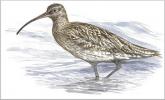Curlew - Numenius arquata
The largest European wader, unmistakable for its long decurved bill.
It gives itself away by its liquid, very sonorous whistle which can be heard over a kilometre away (a sort of "cur-li", from which comes its onomatopoeic name). Sexual dimorphism can be seen in the slightly larger size of the female.
The plumage is tawny in summer, grey in winter; the characteristic black markings which render the livery mimetic remain constant.
Juveniles can be recognised especially by their shorter, straighter bill. Its song is very variable and melodious with flute-like notes with trills.
It nests on the ground in moorlands and coastal and inland marshlands in north Europe (and to a lesser degree in the central parts of the continent).
Curiously, the female is precocious in leaving the nesting ground and leaves the male to look after the young. Thus it is already possible to see the first contingent in migration by July.
In Italy the Curlew migrates twice a year and a few individuals over-winter. It mostly frequents the coastal wetlands.
The areas where it most commonly occurs in Tuscany are the River Ombrone Estuary, the Orbetello Lagoon and the Natural Reserve of the Lame di Fuori of San Rossore.
Nevertheless the species is regularly sighted in the inland waterlands.




